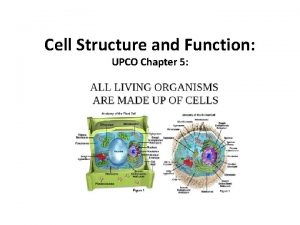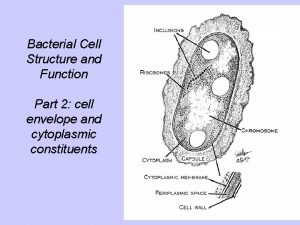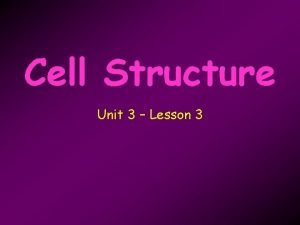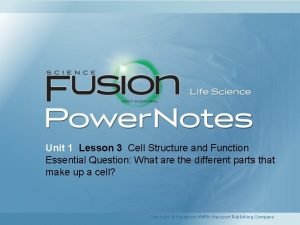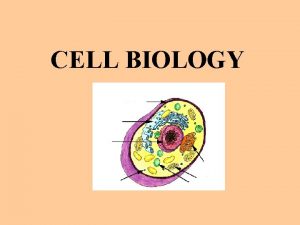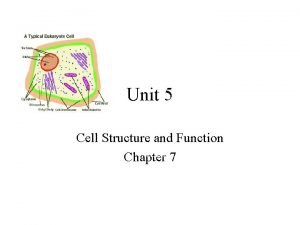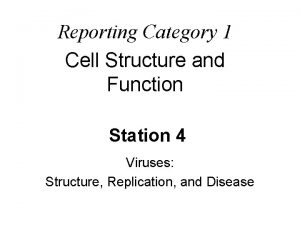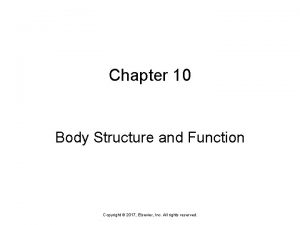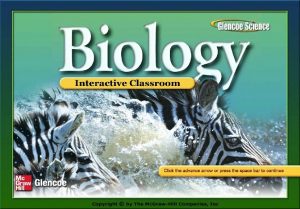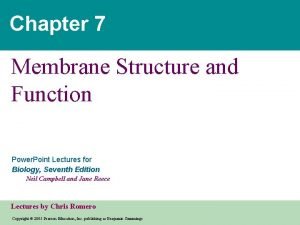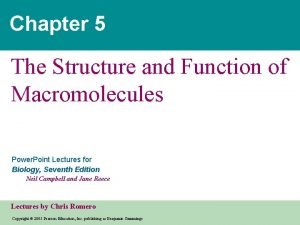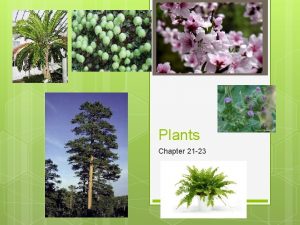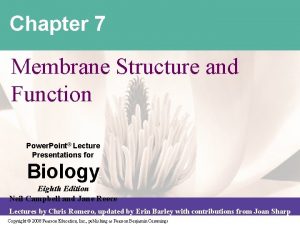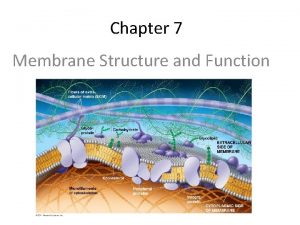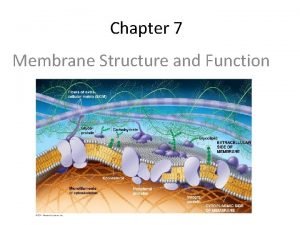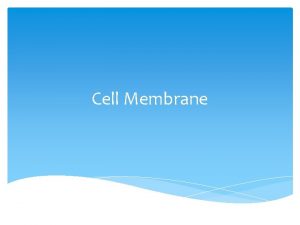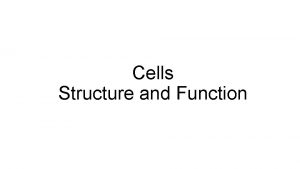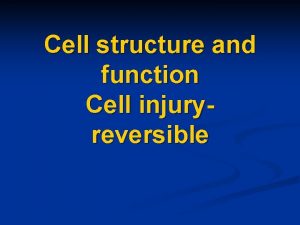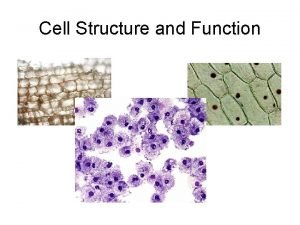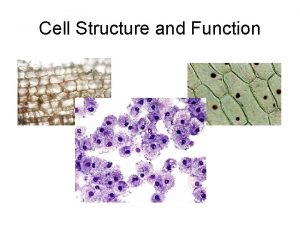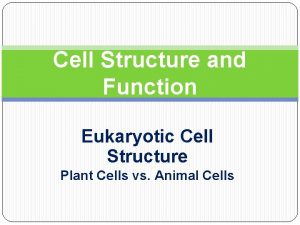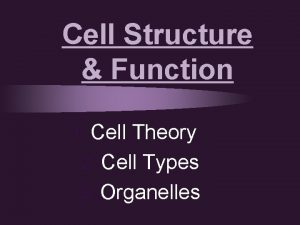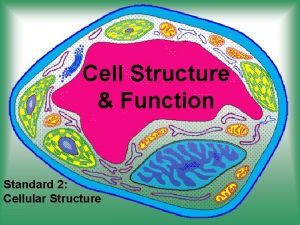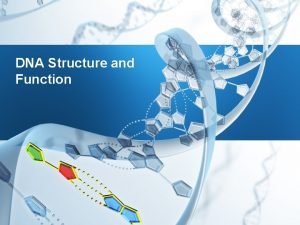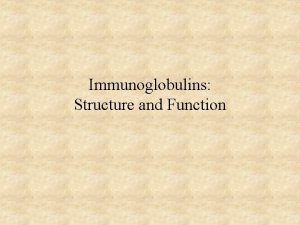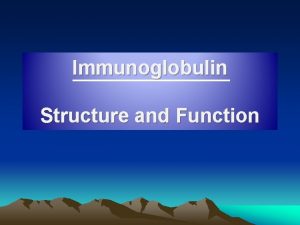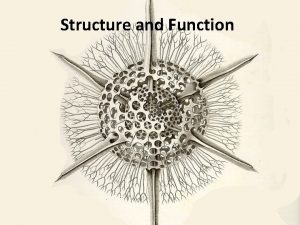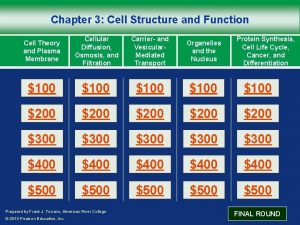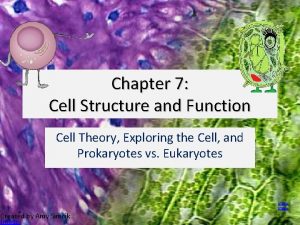Chapter 4 Cell Structure and function Cell Structure









































- Slides: 41

Chapter 4, Cell Structure and function Cell Structure and Function 1

Objectives List the principles of the cell theory. Explain the reason that cell size is limited. State the similarities and differences between prokaryotic and eukaryotic cells. List the components of a typical eukaryotic cell and the function of each. ◦ Plasma membrane: (From Chapter 5 Objectives) Outline the structure of the plasma membrane. Explain the meaning of fluid mosaic to describe plasma membrane structure. In general, list ways in which materials move across the plasma membrane. State the ways in which plant cells are special. 2

Cell Theory States that: ◦ All organisms are composed of cells ◦ All cells come only from preexisting cells ◦ Cells are the smallest structural and functional unit of organisms 3

Cell Diversity Not all cells are alike Cells differ in size, shape, and function The female egg cell is the largest cell in the body & can be seen without a microscope Bacterial cells are some of the smallest cells & are only visible with a microscope 4

Cell Diversity continued Cells come in a variety of shapes, & the shape helps determine the function of the cell (e. g. Nerve cells are long to transmit messages in the body, while red blood cells are disk shaped to move through blood vessels) 5

Cell Size Cells range in size from one millimeter down to one micrometer Cells need a large surface area of plasma membrane to adequately exchange materials (wastes, gases such as O 2 & CO 2, and nutrients) Cells are limited in size by the ratio between their outer surface area & their volume ◦ Small cells have more surface area for their volume of cytoplasm than large cells ◦ Volume is living cytoplasm, which demands nutrients and produces wastes ◦ Cell size is also limited by the amount of cytoplasmic activity that the cell’s nucleus can control ◦ Cells specialized in absorption utilize membrane modifications such as microvilli to greatly increase surface area per unit volume 6

Surface to Volume Ratio Copyright © The Mc. Graw-Hill Companies, Inc. Permission required for reproduction or display. One 4 -cm cube Eight 2 -cm cubes Sixty-four 1 -cm cubes Total surface area (height × width × number of sides × number of cubes) 96 cm 2 192 cm 2 384 cm 2 Total volume (height × width × length × number of cubes) 64 cm 3 Surface area: Volume per cube (surface area ÷ volume) 1. 5: 1 3: 1 6: 1 7

As cells grow, the amount of surface area becomes too small to allow materials to enter & leave the cell quickly enough 8

Prokaryotic Cells Do not have a nucleus & no membranebound organelles Structurally smaller and simpler than eukaryotic cells (which have a nucleus). Unicellular Most have a cell wall surrounding the cell membrane & a single, looped chromosome (genetic material) in the cytoplasm 9

Prokaryotic Cells continued Prokaryotic cells are placed in two taxonomic domains: ◦ Bacteria ◦ Archaea Live in extreme habitats ◦ Domains are structurally similar but biochemically different 10

Eukaryote Cells Domain Eukarya includes: ◦ ◦ Protists Fungi Plants Animals Cells contain: ◦ ◦ ◦ Membrane-bound nucleus that houses DNA Specialized organelles Plasma membrane Much larger than prokaryotic cells Some cells (e. g. , plant cells) have a cell wall 11

Eukaryotic Cells Includes both unicellular & multicellular organisms Do have a true nucleus & membrane-bound organelles Organelles are internal structures in cell’s that perform specific functions ◦ Organelles are surrounded by a single or double membrane a. Nucleus b. Chloroplast c. Golgi d. Mitochondria 12

Eukaryotic Cells: Organelles Two classes of organelles: ◦ Endomembrane system: Organelles that communicate with one another Via membrane channels Via small vesicles ◦ Energy related organelles Mitochondria & chloroplasts Basically independent & self-sufficient 13

Eukaryote Cell Membrane Entire eukaryotic cell surrounded by a thin cell membrane that controls what enters & leaves the cell (AKA Plasma membrane) Separates the cytoplasm of the cell from its environment Protects the cell & controls what enters and leaves Cell membranes are selectively permeable only allowing certain materials to enter or leave Composed of a lipid bilayer made of phospholipid molecules 14

Eukaryote Cell: Cell Membrane The hydrophilic head of a phospholipid is polar & composed of a glycerol & phosphate group and points to the aqueous cytoplasm and external environment. 15

Eukaryote Cell: Cell Membrane The two hydrophobic tails are nonpolar point toward each other in the center of the membrane & are composed of two fatty acids 16

Eukaryote Cell: Cell Membrane When phospholipids are placed in water, they line up on the water’s surface with their heads sticking into the water & their tails pointing upward from the surface. The inside of the cell or cytoplasm is an aqueous or watery environment & so is the outside of the cell. Phospholipid "heads" point toward the water. 17

Eukaryote Cell: Cell Membrane Phospholipid "tails" are sandwiched inside the lipid bilayer. 18

Eukaryote Cell: Cell Membrane The cell membrane is constantly breaking down & being reformed inside living cells. Certain small molecules such as CO 2, H 2 O, & O 2 can easily pass through the phospholipids 19

Eukaryote Cell: Cell Membrane Cell membrane proteins help move materials into & out of the cell. Some integral proteins called channel proteins have holes or pores through them so certain substances can cross the cell membrane. Channel proteins help move ions (charged particles) such as Na+, Ca+, & K+ across the cell membrane 20

Cell Membrane: Channel Proteins 21

Eukaryote Cell: Cell Membrane Transmembrane proteins bind to a substance on one side of the membrane & carry it to the other side. e. g. glucose Some embedded, integral proteins have carbohydrate chains attached to them to serve as chemical signals to help cells recognize each other or for hormones or viruses to attach 22

Eukaryote Cell: Cell Membrane. Fluid Mosaic Model The phospholipids & proteins in a cell membrane can drift or move side to side making the membrane appear "fluid". The proteins embedded in the cell membrane form patterns or mosaics. Because the membrane is fluid with a pattern or mosaic of proteins, the modern view of the cell membrane is called the fluid mosaic model. 23

Internal Cell Structure & Organelles of Eukaryotes Cytoplasm includes everything between the nucleus and cell membrane. ◦ Cytoplasm is composed of organelles & cytosol (jellylike material consisting of mainly water along with proteins). 24

Mitochondria large organelles with double membranes where cellular respiration (breaking down glucose to get energy) occurs ◦ Energy from glucose is used to make ATP or adenosine triphosphate ◦ Cells use the ATP molecule for energy ◦ More active cells like muscle cells have more mitochondria ◦ Outer membrane is smooth, while inner membrane has long folds called cristae ◦ Have their own DNA to make more mitochondria when needed 25

Mitochondria 26

Ribosomes Not surrounded by a membrane & are where proteins are made in the cytoplasm (protein synthesis) Most numerous organelle May be free in the cytoplasm or attached to the rough ER (endoplasmic reticulum) 27

Endoplasmic reticulum Membranous tubules & sacs that transport molecules from one part of the cell to another Rough ER has embedded ribosomes on its surfaces for making proteins Smooth ER lacks ribosomes & helps break down poisons, wastes, & other toxic chemicals Smooth ER also helps process carbohydrates & lipids (fats) The ER network connects the nucleus with the cell membrane 28

Endoplasmic reticulum 29

Golgi Apparatus Modifies, packages, & helps secrete cell products such as proteins and hormones Consists of a stack of flattened sacs called cisternae Receives products made by the ER 30

Lysosomes Small organelles containing hydrolytic enzymes to digest materials for the cell Single membrane Formed from the ends of Golgi that pinch off Found in most cells except plant cells 31

Cytoskeleton Consists of a network of long protein tubes & strands in the cytoplasm to give cells shape and helps move organelles Composed of 2 protein structures --- microtubules, intermediate filaments, & microfilaments Microfilaments are ropelike structures made of 2 twisted strands of the protein actin capable of contracting to cause cellular movement (muscle cells have many microfilaments) Microtubules are larger, hollow tubules of the protein called tubulin that maintain cell shape, serve as tracks for organelle movement, & help cells divide by forming spindle fibers that separate chromosome pairs 32

Cytoskeleton Microtubules ◦ Move materials within the cell Move the cilia and flagella Actin Filaments ◦ Move the cell Intermediate Filaments ◦ Provides mechanical support 33

Cilia Short, more numerous hair like structures made of bundles of microtubules to help cells move ◦ Line respiratory tract to remove dust & move paramecia 34

Flagella Long whip like tails of microtubules bundles used for movement (usually 1 -3 in number) ◦ Help sperm cells swim to egg 35

Eukaryote Cell: Nucleus is located in the center of the cell The nucleus contains the genetic material (DNA) & controls the cell’s activities 36

Nucleus In the middle of the cell contains DNA (hereditary material of the cell) & acts as the control center Most cells have 1 nucleolus, but some have several Has a protein skeleton to keep its shape Surrounded by a double layer called the nuclear envelope containing pores Chromatin is the long strand of DNA in the nucleus, which coils during cell division to make chromosomes Nucleolus (nucleoli) inside the nucleus makes ribosomes & disappears during cell division 37

Nucleus 38

Cell wall NOT IN ANIMALS!!, Nonliving, protective layers around the cell membrane in plants, bacteria, & fungi ◦ Fungal cell walls are made of chitin, while plant cell walls are made of cellulose ◦ Consist of a primary cell wall made first and a woody secondary cell wall in some plants 39

Vacuoles The largest organelle in plants taking up most of the space Serves as a storage area for proteins, ions, wastes, and cell products such as glucose May contain poisons to keep animals from eating them Animal vacuoles are smaller & used for digestion 40

Plastids In plants make or store food & contain pigments to trap sunlight Chloroplast is a plastid that captures sunlight to make O 2 and glucose during photosynthesis; contains chlorophyll ◦ Double membrane organelle with an inner system of membranous sacs called thylakoids ◦ Thylakoids made of stacks of grana containing chlorophyll Other plastids contain red, orange, and yellow pigments Found in plants, algae, & seaweed 41
 Eukaryotic cell structure
Eukaryotic cell structure Chapter 7 cell structure and function section review 7-2
Chapter 7 cell structure and function section review 7-2 Chapter 5 cell structure and function
Chapter 5 cell structure and function What is the function of cell wall in plant cell
What is the function of cell wall in plant cell What is part 2
What is part 2 Lesson 3 cell structure and function answer key
Lesson 3 cell structure and function answer key Organelle graphic organizer answer key
Organelle graphic organizer answer key Plant and animal cell diagram
Plant and animal cell diagram Lesson 3 cell structure and function answer key
Lesson 3 cell structure and function answer key Cell structure and function graphic organizer
Cell structure and function graphic organizer Cell structure and function
Cell structure and function Unit 5 cell structure and function answer key
Unit 5 cell structure and function answer key Category 1 cell structure and function
Category 1 cell structure and function Category 1 cell structure and function
Category 1 cell structure and function Category 1: cell structure and function
Category 1: cell structure and function The scientist mathias schleiden studied _______ in ______.
The scientist mathias schleiden studied _______ in ______. Chapter 10 body structure and function
Chapter 10 body structure and function Chapter 22 plant structure and function answer key
Chapter 22 plant structure and function answer key Chapter 7 membrane structure and function
Chapter 7 membrane structure and function Chapter 5 the structure and function of macromolecules
Chapter 5 the structure and function of macromolecules Chapter 21 plant structure and function
Chapter 21 plant structure and function Chapter 7 membrane structure and function
Chapter 7 membrane structure and function Flaccid cell
Flaccid cell Chapter 7 membrane structure and function
Chapter 7 membrane structure and function Chapter 23 plant structure and function
Chapter 23 plant structure and function Advantages of diaphragm cell
Advantages of diaphragm cell Prokaryotic and eukaryotic cells
Prokaryotic and eukaryotic cells Venn diagram of organelles in plant and animal cells
Venn diagram of organelles in plant and animal cells Vacuole function
Vacuole function Primary source batteries
Primary source batteries Difference between plant and animal cell
Difference between plant and animal cell Section 10-2 cell division
Section 10-2 cell division Life
Life Idealized plant cell
Idealized plant cell Walker cell and hadley cell
Walker cell and hadley cell Cell cycle and cell division
Cell cycle and cell division Plant cell vs animal cell venn diagram
Plant cell vs animal cell venn diagram Mitosis
Mitosis Galvanic vs electrolytic cell
Galvanic vs electrolytic cell Animal cell and plant cell
Animal cell and plant cell Location of cell membrane
Location of cell membrane Secondary education meaning
Secondary education meaning


